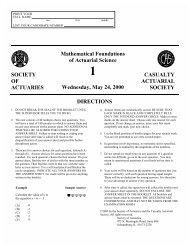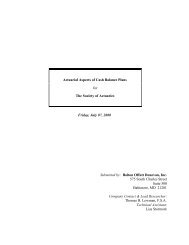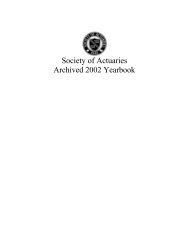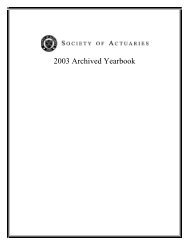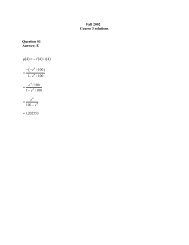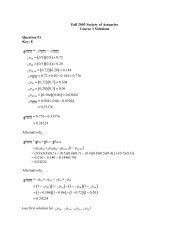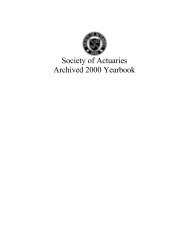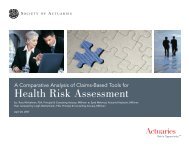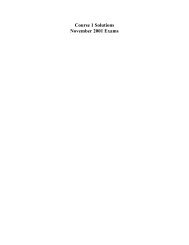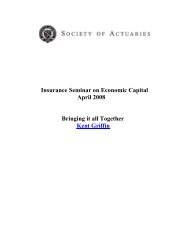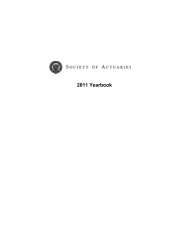Course 4 May 2000 Multiple Choice Exams
Course 4 May 2000 Multiple Choice Exams
Course 4 May 2000 Multiple Choice Exams
You also want an ePaper? Increase the reach of your titles
YUMPU automatically turns print PDFs into web optimized ePapers that Google loves.
**BEGINNING OF EXAMINATION**<br />
1. You fit the following model to 20 observations:<br />
Y = α+ βX<br />
+ ε<br />
You determine that R 2 = 0. 64.<br />
Calculate the value of the F statistic used to test for a linear relationship.<br />
(A) Less than 30<br />
(B) At least 30, but less than 33<br />
(C) At least 33, but less than 36<br />
(D) At least 36, but less than 39<br />
(E) At least 39<br />
COURSE/EXAM 4: MAY <strong>2000</strong> - 1 - GO ON TO NEXT PAGE
2. You are given the following random sample of ten claims:<br />
46 121 493 738 775<br />
1078 1452 2054 2199 3207<br />
Determine the smoothed empirical estimate of the 90 th percentile, as defined in Klugman, Panjer<br />
and Willmot.<br />
(A) Less than 2150<br />
(B) At least 2150, but less than 2500<br />
(C) At least 2500, but less than 2850<br />
(D) At least 2850, but less than 3200<br />
(E) At least 3200<br />
COURSE/EXAM 4: MAY <strong>2000</strong> - 2 - GO ON TO NEXT PAGE
3. You are given the following information about two classes of business, where X is the loss for an<br />
individual insured:<br />
Class 1 Class 2<br />
Number of insureds 25 50<br />
b g 380 23<br />
c h 365,000 ----<br />
E X<br />
E X 2<br />
You are also given that an analysis has resulted in a Bühlmann k value of 2.65.<br />
Calculate the process variance for Class 2.<br />
(A) 2,280<br />
(B) 2,810<br />
(C) 7,280<br />
(D) 28,320<br />
(E) 75,050<br />
COURSE/EXAM 4: MAY <strong>2000</strong> - 3 - GO ON TO NEXT PAGE
4. For a mortality study with right-censored data, you are given:<br />
Time<br />
t i<br />
5<br />
7<br />
10<br />
12<br />
Number of Deaths<br />
d i<br />
2<br />
1<br />
1<br />
2<br />
Number at Risk<br />
Y i<br />
15<br />
12<br />
10<br />
6<br />
Calculate ~ S 12<br />
b g based on the Nelson-Aalen estimate H ~ b12g.<br />
(A) 0.48<br />
(B) 0.52<br />
(C) 0.60<br />
(D) 0.65<br />
(E) 0.67<br />
COURSE/EXAM 4: MAY <strong>2000</strong> - 4 - GO ON TO NEXT PAGE
5. You are given the following information about an MA(4) model:<br />
m<br />
q1<br />
q2<br />
q3<br />
q4<br />
2<br />
s e<br />
=<br />
=<br />
=<br />
=<br />
=<br />
=<br />
0<br />
1800 .<br />
−1110<br />
.<br />
0.<br />
278<br />
−0.<br />
024<br />
8.<br />
000<br />
Determine the standard deviation of the forecast error three steps ahead.<br />
(A) 2.8<br />
(B) 3.6<br />
(C) 4.9<br />
(D) 5.8<br />
(E) 6.6<br />
COURSE/EXAM 4: MAY <strong>2000</strong> - 5 - GO ON TO NEXT PAGE
6. A jewelry store has obtained two separate insurance policies that together provide full coverage.<br />
You are given:<br />
(i) The average ground-up loss is 11,100.<br />
(ii)<br />
Policy A has an ordinary deductible of 5,000 with no policy limit.<br />
(iii) Under policy A, the expected amount paid per loss is 6,500.<br />
(iv) Under policy A, the expected amount paid per payment is 10,000.<br />
(v) Policy B has no deductible and a policy limit of 5,000.<br />
Given that a loss less than or equal to 5,000 has occurred, what is the expected payment under<br />
policy B?<br />
(A) Less than 2,500<br />
(B) At least 2,500, but less than 3,000<br />
(C) At least 3,000, but less than 3,500<br />
(D) At least 3,500, but less than 4,000<br />
(E) At least 4,000<br />
COURSE/EXAM 4: MAY <strong>2000</strong> - 6 - GO ON TO NEXT PAGE
7. You are given the following information about two classes of risks:<br />
(i)<br />
(ii)<br />
Risks in Class A have a Poisson claim count distribution with a mean of 1.0 per year.<br />
Risks in Class B have a Poisson claim count distribution with a mean of 3.0 per year.<br />
(iii) Risks in Class A have an exponential severity distribution with a mean of 1.0.<br />
(iv) Risks in Class B have an exponential severity distribution with a mean of 3.0.<br />
(v)<br />
(vi)<br />
Each class has the same number of risks.<br />
Within each class, severities and claim counts are independent.<br />
A risk is randomly selected and observed to have two claims during one year. The observed<br />
claim amounts were 1.0 and 3.0.<br />
Calculate the posterior expected value of the aggregate loss for this risk during the next year.<br />
(A) Less than 2.0<br />
(B) At least 2.0, but less than 4.0<br />
(C) At least 4.0, but less than 6.0<br />
(D) At least 6.0, but less than 8.0<br />
(E) At least 8.0<br />
COURSE/EXAM 4: MAY <strong>2000</strong> - 7 - GO ON TO NEXT PAGE
8. You are given the following data on time to death:<br />
(i)<br />
Time<br />
t i<br />
Number of Deaths<br />
d i<br />
Number of Risks<br />
Y i<br />
( t i<br />
)<br />
H ~<br />
10 1 20 0.0500<br />
34 1 19 0.1026<br />
47 1 18 0.1582<br />
75 1 17 0.2170<br />
156 1 16 0.2795<br />
171 1 15 0.3462<br />
(ii) H ~ ( t i<br />
)<br />
is the Nelson-Aalen estimate of the cumulative hazard function.<br />
(iii) h $ ( t ), the kernel-smoothed estimate of the hazard rate, is determined using bandwidth 60<br />
and the uniform kernel<br />
K<br />
( x )<br />
=<br />
R<br />
S|<br />
T|<br />
1<br />
2<br />
,<br />
− 1 ≤ x ≤ 1<br />
0 , o t h e r w i s e .<br />
Determine h $ ( 100 ) .<br />
(A) 0.0010<br />
(B) 0.0015<br />
(C) 0.0029<br />
(D) 0.0590<br />
(E) 0.0885<br />
COURSE/EXAM 4: MAY <strong>2000</strong> - 8 - GO ON TO NEXT PAGE
9. The following models are fitted to 30 observations:<br />
You are given:<br />
Model I: Y = β + β X + ε<br />
1 2 2<br />
Model II: Y = β + β X + β X + β X + ε<br />
(i) ∑cY − Yh = 160<br />
(ii)<br />
2<br />
∑c X2 X2h<br />
− = 10<br />
(iii) For Model I, β $ 2<br />
= −2<br />
1 2 2 3 3 4 4<br />
(iv) For Model II, R 2 = 070 .<br />
Determine the value of the F statistic used to test that β 3<br />
and β 4<br />
are jointly equal to zero.<br />
(A) Less than 15<br />
(B) At least 15, but less than 18<br />
(C) At least 18, but less than 21<br />
(D) At least 21, but less than 24<br />
(E) At least 24<br />
COURSE/EXAM 4: MAY <strong>2000</strong> - 9 - GO ON TO NEXT PAGE
10-11. Use the following information for questions 10 and 11.<br />
The size of a claim for an individual insured follows an inverse exponential distribution with the<br />
following probability density function:<br />
θ −θ<br />
x<br />
e<br />
f ( x θ) = , x ><br />
x<br />
2<br />
0<br />
The parameter θ has a prior distribution with the following probability density function:<br />
−θ<br />
e<br />
gbθg 4<br />
= , θ > 0<br />
4<br />
10. For question 10 only, you are also given:<br />
One claim of size 2 has been observed for a particular insured.<br />
Which of the following is proportional to the posterior distribution of θ?<br />
(A)<br />
θe −θ<br />
2<br />
(B) θ θ<br />
e −3 4<br />
(C)<br />
(D)<br />
(E)<br />
θe −θ<br />
θ<br />
θ<br />
2<br />
θ<br />
e − 2<br />
2<br />
θ<br />
e −9 4<br />
COURSE/EXAM 4: MAY <strong>2000</strong> - 10 - GO ON TO NEXT PAGE
10-11. (Repeated for convenience) Use the following information for questions 10 and 11.<br />
The size of a claim for an individual insured follows an inverse exponential distribution with the<br />
following probability density function:<br />
θ −θ<br />
x<br />
e<br />
f ( x θ) = , x ><br />
x<br />
2<br />
0<br />
The parameter θ has a prior distribution with the following probability density function:<br />
−θ<br />
e<br />
gbθg 4<br />
= , θ > 0<br />
4<br />
11. For question 11 only, you are also given:<br />
For a particular insured, the following five claims are observed:<br />
1 2 3 5 13<br />
Determine the value of the Kolmogorov-Smirnov statistic to test the goodness of fit of<br />
f xθ = 2 c h.<br />
(A) Less than 0.05<br />
(B) At least 0.05, but less than 0.10<br />
(C) At least 0.10, but less than 0.15<br />
(D) At least 0.15, but less than 0.20<br />
(E) At least 0.20<br />
COURSE/EXAM 4: MAY <strong>2000</strong> - 11 - GO ON TO NEXT PAGE
12. For a mortality study, you are given:<br />
(i)<br />
(ii)<br />
(iii)<br />
(iv)<br />
(v)<br />
100 newborn mice are observed for four months.<br />
H 0 is a hypothesized cumulative hazard function.<br />
Deaths during the month are assumed to occur at the end of the month.<br />
The 95 th percentile of the chi-square distribution with one degree of freedom<br />
is 3.84.<br />
The observed mortality experience and the values of H 0 are given below.<br />
Month<br />
Number at<br />
beginning of month<br />
Number<br />
of deaths<br />
H 0, beginning<br />
of month<br />
H 0, end<br />
of month<br />
1 100 10 0.00 0.08<br />
2 90 12 0.08 0.15<br />
3 78 10 0.15 0.25<br />
4 68 d 4 0.25 0.40<br />
Calculate the smallest value of d 4 needed for the one-sample log-rank test to yield the<br />
conclusion, at the 0.05 significance level, that the true cumulative hazard function differs<br />
from H 0 .<br />
(A) 0<br />
(B) 3<br />
(C) 6<br />
(D) 9<br />
(E) 12<br />
COURSE/EXAM 4: MAY <strong>2000</strong> - 12 - GO ON TO NEXT PAGE
13. You smooth a time series y t<br />
using Holt’s two-parameter exponential smoothing method.<br />
You calculate:<br />
t<br />
yt<br />
y~<br />
t<br />
r t<br />
1995 120.5 120.0 10.0<br />
1996 135.0 131.5 11.2<br />
1997 147.7 144.2 12.4<br />
1998 146.6<br />
~ y1998 r 1998<br />
Determine the two-period forecast $y <strong>2000</strong> by first completing Holt’s two-parameter exponential<br />
smoothed series.<br />
(A) Less than 166<br />
(B) At least 166, but less than 168<br />
(C) At least 168, but less than 170<br />
(D) At least 170, but less than 172<br />
(E) At least 172<br />
COURSE/EXAM 4: MAY <strong>2000</strong> - 13 - GO ON TO NEXT PAGE
14. Which of the following statements about evaluating an estimator is false?<br />
(A)<br />
Modeling error is not possible with empirical estimation.<br />
^ ^ ^)<br />
(B) MSE( θ) = Var( θ) + Bias(<br />
θ<br />
n<br />
2 1<br />
2<br />
(C) Sn<br />
= ∑d X<br />
j<br />
− Xi is an asymptotically unbiased estimator of variance.<br />
n<br />
(D)<br />
j=<br />
1<br />
If θ^n is asymptotically unbiased and limVar( θ ) =<br />
2<br />
n →∞<br />
^<br />
n<br />
^<br />
0, then θ n<br />
is weakly consistent.<br />
(E)<br />
A robust estimator is one that performs well even with sampling error.<br />
COURSE/EXAM 4: MAY <strong>2000</strong> - 14 - GO ON TO NEXT PAGE
15. An insurer has data on losses for four policyholders for seven years. X ij is the loss from<br />
the i th policyholder for year j.<br />
You are given:<br />
4<br />
∑∑<br />
i=<br />
1<br />
7<br />
j=<br />
1<br />
d<br />
X<br />
ij<br />
− X = 33.<br />
60<br />
i<br />
i<br />
2<br />
4<br />
∑<br />
i=<br />
1<br />
c<br />
X<br />
i<br />
h<br />
2<br />
− X = 3.<br />
30<br />
Calculate the Bühlmann credibility factor for an individual policyholder using nonparametric<br />
empirical Bayes estimation.<br />
(A) Less than 0.74<br />
(B) At least 0.74, but less than 0.77<br />
(C) At least 0.77, but less than 0.80<br />
(D) At least 0.80, but less than 0.83<br />
(E) At least 0.83<br />
COURSE/EXAM 4: MAY <strong>2000</strong> - 15 - GO ON TO NEXT PAGE
16. You are given:<br />
(i)<br />
x 1 = −2<br />
x 2 = −1<br />
x 3 = 0<br />
x 4 = 1<br />
x 5 = 2<br />
(ii) The true model for the data is y = 10x + 3x<br />
2 + ε .<br />
* * .<br />
(iii) The model fitted to the data is y = β x + ε<br />
Determine the expected value of the least-squares estimator of β * .<br />
(A) 6<br />
(B) 7<br />
(C) 8<br />
(D) 9<br />
(E) 10<br />
COURSE/EXAM 4: MAY <strong>2000</strong> - 16 - GO ON TO NEXT PAGE
17. You are given a random sample of two values from a distribution function F:<br />
1 3<br />
b g<br />
You estimate θ F<br />
X<br />
X =<br />
+ X<br />
2<br />
1 2<br />
.<br />
2<br />
1<br />
= Var b Xg<br />
using the estimator g( X1, X2) = ∑ ( Xi<br />
− X )<br />
2<br />
i=<br />
1<br />
2<br />
, where<br />
Determine the bootstrap approximation to the mean square error.<br />
(A) 0.0<br />
(B) 0.5<br />
(C) 1.0<br />
(D) 2.0<br />
(E) 2.5<br />
COURSE/EXAM 4: MAY <strong>2000</strong> - 17 - GO ON TO NEXT PAGE
18. You are given two independent estimates of an unknown quantityµ:<br />
b g<br />
b g<br />
b g<br />
b g<br />
(i) Estimate A: E µ A<br />
= 1000 and σ µ A<br />
= 400<br />
(ii) Estimate B: E µ B<br />
= 1200 and σ µ B<br />
= 200<br />
Estimate C is a weighted average of the two estimates A and B, such that:<br />
µ = w⋅ µ + 1− w ⋅µ<br />
C A B<br />
b<br />
g<br />
Determine the value of w that minimizes σ bµ C g .<br />
(A) 0<br />
(B) 1/5<br />
(C) 1/4<br />
(D) 1/3<br />
(E) 1/2<br />
COURSE/EXAM 4: MAY <strong>2000</strong> - 18 - GO ON TO NEXT PAGE
19. For a mortality study with right-censored data, the cumulative hazard rate is estimated using the<br />
Nelson-Aalen estimator.<br />
You are given:<br />
(i) No deaths occur between times t i and t i+1 .<br />
(ii) A 95% linear confidence interval for H(t i ) is (0.07125, 0.22875).<br />
(iii) A 95% linear confidence interval for H(t i+1 ) is (0.15607, 0.38635).<br />
Calculate the number of deaths observed at time t i+1 .<br />
(A) 4<br />
(B) 5<br />
(C) 6<br />
(D) 7<br />
(E) 8<br />
COURSE/EXAM 4: MAY <strong>2000</strong> - 19 - GO ON TO NEXT PAGE
20. For the time series y t , you are given:<br />
t y t<br />
yt − y<br />
1 984 −16<br />
2 1023 23<br />
3 965 −35<br />
4 1040 40<br />
5 988 −12<br />
Estimate the partial autocorrelation function at time displacement k = 2 .<br />
(A) −0.46<br />
(B) −0.16<br />
(C) 0.00<br />
(D) 0.51<br />
(E) 0.84<br />
COURSE/EXAM 4: MAY <strong>2000</strong> - 20 - GO ON TO NEXT PAGE
21. You are given the following five observations:<br />
521 658 702 819 1217<br />
You use the single-parameter Pareto with cumulative distribution function<br />
Fbxg F = − x<br />
H G α<br />
500<br />
1<br />
I<br />
x K J , > 500, α > 0.<br />
Calculate the maximum likelihood estimate of the parameter α .<br />
(A) 2.2<br />
(B) 2.5<br />
(C) 2.8<br />
(D) 3.1<br />
(E) 3.4<br />
COURSE/EXAM 4: MAY <strong>2000</strong> - 21 - GO ON TO NEXT PAGE
22. You are given:<br />
(i) A portfolio of independent risks is divided into two classes, Class A and Class B.<br />
(ii) There are twice as many risks in Class A as in Class B.<br />
(iii)<br />
(iv)<br />
The number of claims for each insured during a single year follows a Bernoulli<br />
distribution.<br />
Classes A and B have claim size distributions as follows:<br />
Claim Size Class A Class B<br />
50,000 0.60 0.36<br />
100,000 0.40 0.64<br />
(v) The expected number of claims per year is 0.22 for Class A and 0.11 for Class B.<br />
One insured is chosen at random. The insured’s loss for two years combined is 100,000.<br />
Calculate the probability that the selected insured belongs to Class A.<br />
(A) 0.55<br />
(B) 0.57<br />
(C) 0.67<br />
(D) 0.71<br />
(E) 0.73<br />
COURSE/EXAM 4: MAY <strong>2000</strong> - 22 - GO ON TO NEXT PAGE
23. You test the effect of gender and age on survival of patients receiving kidney transplants.<br />
(i)<br />
(ii)<br />
You use a Cox proportional hazards model with the indicator variable Z 1<br />
equal to 1 when<br />
the subject is a male, and the indicator variable Z 2<br />
equal to 1 when the subject is an adult.<br />
The resulting partial maximum likelihood parameter estimates are:<br />
b 1 = 0.25<br />
b 2 = −0.45<br />
(iii)<br />
The variance-covariance matrix of b 1 and b 2 is given by:<br />
F<br />
HG<br />
036 . 010 .<br />
010 . 020 .<br />
I<br />
KJ<br />
Which of the following is a 95% confidence interval for the relative risk of a male child subject<br />
compared to a female adult subject?<br />
(A) (−0.5, 1.9)<br />
(B) (0.0, 1.4)<br />
(C) (0.6, 6.5)<br />
(D) (1.0, 4.1)<br />
(E) (1.2, 3.2)<br />
COURSE/EXAM 4: MAY <strong>2000</strong> - 23 - GO ON TO NEXT PAGE
24. You are given the following linear regression results:<br />
t Actual Fitted<br />
1 77.0 77.6<br />
2 69.9 70.6<br />
3 73.2 70.9<br />
4 72.7 72.7<br />
5 66.1 67.1<br />
Estimate the lag 1 serial correlation coefficient for the residuals, using the Durbin-Watson<br />
statistic.<br />
(A) Less than −0.2<br />
(B) At least −0.2, but less than −0.1<br />
(C) At least −0.1, but less than 0.0<br />
(D) At least 0.0, but less than 0.1<br />
(E) At least 0.1<br />
COURSE/EXAM 4: MAY <strong>2000</strong> - 24 - GO ON TO NEXT PAGE
25. You model a loss process using a lognormal distribution with parameters µ and σ .<br />
You are given:<br />
(i)<br />
The maximum likelihood estimates of µ and σ are:<br />
^<br />
µ<br />
^<br />
σ<br />
= 4.<br />
215<br />
= 1093 .<br />
(ii) The estimated covariance matrix of µ^ and σ^ is:<br />
⎛01195 . 0 ⎞<br />
⎜<br />
⎟<br />
⎝ 0 0.<br />
0597⎠<br />
(iii) The mean of the lognormal distribution is exp( µ + σ 2<br />
)<br />
2 .<br />
Estimate the variance of the maximum likelihood estimate of the mean of the lognormal<br />
distribution, using the delta method.<br />
(A) Less than 1500<br />
(B) At least 1500, but less than <strong>2000</strong><br />
(C) At least <strong>2000</strong>, but less than 2500<br />
(D) At least 2500, but less than 3000<br />
(E) At least 3000<br />
COURSE/EXAM 4: MAY <strong>2000</strong> - 25 - GO ON TO NEXT PAGE
26. You are given:<br />
(i)<br />
Claim counts follow a Poisson distribution.<br />
(ii) Claim sizes follow a lognormal distribution with coefficient of variation 3.<br />
(iii)<br />
Claim sizes and claim counts are independent.<br />
(iv) The number of claims in the first year was 1000.<br />
(v)<br />
(vi)<br />
(vii)<br />
(viii)<br />
The aggregate loss in the first year was 6.75 million.<br />
The manual premium for the first year was 5.00 million.<br />
The exposure in the second year is identical to the exposure in the first year.<br />
The full credibility standard is to be within 5% of the expected aggregate loss 95% of the<br />
time.<br />
Determine the limited fluctuation credibility net premium (in millions) for the second year.<br />
(A) Less than 5.5<br />
(B) At least 5.5, but less than 5.7<br />
(C) At least 5.7, but less than 5.9<br />
(D) At least 5.9, but less than 6.1<br />
(E) At least 6.1<br />
COURSE/EXAM 4: MAY <strong>2000</strong> - 26 - GO ON TO NEXT PAGE
27. You are analyzing the time between the occurrence and payment of claims. You are given the<br />
following data on four claims that were paid during the time period t = 0 to<br />
t = 6 (in months):<br />
Time of occurrence<br />
(t)<br />
Time between<br />
occurrence and<br />
payment<br />
3 1<br />
5 1<br />
3 2<br />
2 3<br />
You have no information on claims that occurred during the period t = 0 to t = 6 but were not<br />
paid until after t = 6.<br />
Given that a claim is paid no later than six months after its occurrence, using the appropriate<br />
form of the Product-Limit estimator, estimate the probability that the claim is paid less than two<br />
months after its occurrence.<br />
(A) 0<br />
(B) 1/4<br />
(C) 1/3<br />
(D) 1/2<br />
(E) 2/3<br />
COURSE/EXAM 4: MAY <strong>2000</strong> - 27 - GO ON TO NEXT PAGE
28. You are given two time series, xt<br />
and y t<br />
. Each time series is assumed to be a random walk.<br />
Which of the following statements about these series is correct?<br />
(A)<br />
No linear combination of these two time series can be stationary.<br />
(B) The time series zt = xt − λ yt<br />
is always stationary for some value λ.<br />
(C) The time series zt = xt − λ yt<br />
may be stationary for some value λ that can be determined<br />
precisely using regression techniques.<br />
(D) The time series zt = xt − λ yt<br />
may be stationary for some value λ that can be estimated<br />
by running an ordinary least-squares regression of x<br />
t<br />
on y<br />
t<br />
.<br />
(E)<br />
None of (A), (B), (C) or (D) is correct.<br />
COURSE/EXAM 4: MAY <strong>2000</strong> - 28 - GO ON TO NEXT PAGE
29. You are given the following observed claim frequency data collected over a period of 365 days:<br />
Number of Claims per Day<br />
Observed Number of Days<br />
0 50<br />
1 122<br />
2 101<br />
3 92<br />
4+ 0<br />
Fit a Poisson distribution to the above data, using the method of maximum likelihood.<br />
Group the data by number of claims per day into four groups:<br />
0 1 2 3 or more<br />
Apply the chi-square goodness-of-fit test to evaluate the null hypothesis that the claims follow a<br />
Poisson distribution.<br />
Determine the result of the chi-square test.<br />
(A)<br />
(B)<br />
(C)<br />
(D)<br />
(E)<br />
Reject at the 0.005 significance level.<br />
Reject at the 0.010 significance level, but not at the 0.005 level.<br />
Reject at the 0.025 significance level, but not at the 0.010 level.<br />
Reject at the 0.050 significance level, but not at the 0.025 level.<br />
Do not reject at the 0.050 significance level.<br />
COURSE/EXAM 4: MAY <strong>2000</strong> - 29 - GO ON TO NEXT PAGE
30. You are given:<br />
(i)<br />
An individual automobile insured has an annual claim frequency distribution that follows<br />
a Poisson distribution with mean λ.<br />
(ii) λ follows a gamma distribution with parametersαand θ.<br />
(iii) The first actuary assumes that α =1 and θ = 1/6.<br />
(iv)<br />
(v)<br />
(vi)<br />
The second actuary assumes the same mean for the gamma distribution, but only half the<br />
variance.<br />
A total of one claim is observed for the insured over a three year period.<br />
Both actuaries determine the Bayesian premium for the expected number of claims in the<br />
next year using their model assumptions.<br />
Determine the ratio of the Bayesian premium that the first actuary calculates to the Bayesian<br />
premium that the second actuary calculates.<br />
(A) 3/4<br />
(B) 9/11<br />
(C) 10/9<br />
(D) 11/9<br />
(E) 4/3<br />
COURSE/EXAM 4: MAY <strong>2000</strong> - 30 - GO ON TO NEXT PAGE
31. You fit the following model to 48 observations:<br />
You are given:<br />
Y = β + β X + β X + β X + ε<br />
1 2 2 3 3 4 4<br />
Source<br />
of Variation<br />
Degrees<br />
of Freedom<br />
Sum<br />
of Squares<br />
Regression 3 103,658<br />
Error 44 69,204<br />
Calculate R 2 , the corrected R 2 .<br />
(A) 0.57<br />
(B) 0.58<br />
(C) 0.59<br />
(D) 0.60<br />
(E) 0.61<br />
COURSE/EXAM 4: MAY <strong>2000</strong> - 31 - GO ON TO NEXT PAGE
32. You are given the following information about a sample of data:<br />
(i) Mean = 35,000<br />
(ii) Standard deviation = 75,000<br />
(iii) Median = 10,000<br />
(iv) 90 th percentile = 100,000<br />
(v)<br />
The sample is assumed to be from a Weibull distribution.<br />
Determine the percentile matching estimate of the parameter τ .<br />
(A) Less than 0.25<br />
(B) At least 0.25, but less than 0.35<br />
(C) At least 0.35, but less than 0.45<br />
(D) At least 0.45, but less than 0.55<br />
(E) At least 0.55<br />
COURSE/EXAM 4: MAY <strong>2000</strong> - 32 - GO ON TO NEXT PAGE
33. The number of claims a driver has during the year is assumed to be Poisson distributed with an<br />
unknown mean that varies by driver.<br />
The experience for 100 drivers is as follows:<br />
Number of Claims<br />
during the Year<br />
Number of Drivers<br />
0 54<br />
1 33<br />
2 10<br />
3 2<br />
4 1<br />
Determine the credibility of one year’s experience for a single driver using semiparametric<br />
empirical Bayes estimation.<br />
(A) 0.046<br />
(B) 0.055<br />
(C) 0.061<br />
(D) 0.068<br />
(E) 0.073<br />
COURSE/EXAM 4: MAY <strong>2000</strong> - 33 - GO ON TO NEXT PAGE
34. In a mortality study, the Weibull distribution with parameters λ and α was used as the survival<br />
model, and log time Y was modeled as Y = µ + σ W, with W having the standard extreme value<br />
distribution. The parameters satisfy the relations:<br />
The maximum likelihood estimates of the parameters are µ^ = 4.13 and σ^ =1.39.<br />
The estimated variance-covariance matrix of µ<br />
F<br />
HG<br />
^<br />
0. 075 0016 .<br />
0016 . 0048 .<br />
I<br />
KJ<br />
and<br />
^<br />
σ<br />
is:<br />
Use the delta method to estimate the covariance of α^<br />
and lnd ^λ i.<br />
(A) Less than −0.054<br />
(B) At least −0.054, but less than −0.018<br />
(C) At least −0.018, but less than 0.018<br />
(D) At least 0.018, but less than 0.054<br />
(E) At least 0.054<br />
COURSE/EXAM 4: MAY <strong>2000</strong> - 34 - GO ON TO NEXT PAGE
35. You fit the following model to 30 observations:<br />
(i) s 2 = 10<br />
Y = β + β X + β X + ε<br />
1 2 2 3 3<br />
(ii)<br />
r x 2 x<br />
= 0.<br />
5<br />
3<br />
∑<br />
2<br />
(iii) ( X − X ) = 4<br />
∑<br />
2 2<br />
2<br />
(iv) ( X − X ) = 8<br />
3 3<br />
Determine the estimate of the standard deviation of the least-squares estimate of the difference<br />
between β 2<br />
and β 3<br />
.<br />
(A) 1.7<br />
(B) 2.2<br />
(C) 2.7<br />
(D) 3.2<br />
(E) 3.7<br />
COURSE/EXAM 4: MAY <strong>2000</strong> - 35 - GO ON TO NEXT PAGE
36. You are given the following sample of five claims:<br />
4 5 21 99 421<br />
You fit a Pareto distribution using the method of moments.<br />
Determine the 95 th percentile of the fitted distribution.<br />
(A) Less than 380<br />
(B) At least 380, but less than 395<br />
(C) At least 395, but less than 410<br />
(D) At least 410, but less than 425<br />
(E) At least 425<br />
COURSE/EXAM 4: MAY <strong>2000</strong> - 36 - GO ON TO NEXT PAGE
37. You are given:<br />
(i)<br />
X i<br />
is the claim count observed for driver i for one year.<br />
(ii) X i<br />
has a negative binomial distribution with parameters β = 0.5 and r i .<br />
(iii)<br />
µ i<br />
is the expected claim count for driver i for one year.<br />
(iv) The µ i ’s have an exponential distribution with mean 0.2.<br />
Determine the Bühlmann credibility factor for an individual driver for one year.<br />
(A) Less than 0.05<br />
(B) At least 0.05, but less than 0.10<br />
(C) At least 0.10, but less than 0.15<br />
(D) At least 0.15, but less than 0.20<br />
(E) At least 0.20<br />
COURSE/EXAM 4: MAY <strong>2000</strong> - 37 - GO ON TO NEXT PAGE
38. A mortality study is conducted on 50 lives observed from time zero.<br />
You are given:<br />
(i)<br />
Time<br />
t<br />
Number of Deaths<br />
d t<br />
Number Censored<br />
c t<br />
15 2 0<br />
17 0 3<br />
25 4 0<br />
30 0 c 30<br />
32 8 0<br />
40 2 0<br />
(ii) S $ b 35 g is the Product-Limit estimate of Sb35g .<br />
(iii) V$ S$<br />
b35g is the estimate of the variance of S $ b35g using Greenwood’s formula.<br />
(iv)<br />
b g<br />
2<br />
b g<br />
V$ S$<br />
35<br />
S$<br />
35<br />
= 0.<br />
011467<br />
Determine c 30 , the number censored at time 30.<br />
(A) 3<br />
(B) 6<br />
(C) 7<br />
(D) 8<br />
(E) 11<br />
COURSE/EXAM 4: MAY <strong>2000</strong> - 38 - GO ON TO NEXT PAGE
39. You fit an AR(1) model to the following data:<br />
y<br />
y<br />
y<br />
y<br />
y<br />
1<br />
2<br />
3<br />
4<br />
5<br />
= 2.<br />
0<br />
= −1.7<br />
= 1.5<br />
= −2.0<br />
= 1.5<br />
You choose as initial valuesε = 0, µ = 0 and ρ = 0.5.<br />
1 1<br />
2<br />
Determine the value of the sum of squares function S = ∑ εt<br />
ε<br />
1<br />
= 0, µ = 0, ρ1<br />
= 05 . .<br />
(A) 2<br />
(B) 12<br />
(C) 15<br />
(D) 21<br />
(E) 27<br />
COURSE/EXAM 4: MAY <strong>2000</strong> - 39 - GO ON TO NEXT PAGE
40. You are given the following accident data from 1000 insurance policies:<br />
Number of accidents Number of policies<br />
0 100<br />
1 267<br />
2 311<br />
3 208<br />
4 87<br />
5 23<br />
6 4<br />
7+ 0<br />
Total 1000<br />
Which of the following distributions would be the most appropriate model for this data?<br />
(A)<br />
(B)<br />
(C)<br />
(D)<br />
(E)<br />
Binomial<br />
Poisson<br />
Negative Binomial<br />
Normal<br />
Gamma<br />
**END OF EXAMINATION**<br />
COURSE/EXAM 4: MAY <strong>2000</strong> - 40 - STOP
Solutions to <strong>May</strong> <strong>2000</strong> <strong>Course</strong> 4 Exam<br />
When referencing textbooks, KM = Survival Analysis, KPW = Loss Models, PR =<br />
Econometric Models and Economic Forecasts, R = Simulation<br />
1. From (4.12) on p. 91 of PR,<br />
.64 20 2<br />
F = = = 32 . (B)<br />
2<br />
R N −k<br />
−<br />
2<br />
1−R<br />
k −1 1 −.64 2−1<br />
RSS /( k−1)<br />
2<br />
Alternatively, from the three definitions, F =<br />
, R = RSS / TSS , and<br />
ESS /( N − k )<br />
TSS = RSS + ESS , it is possible to use the given information to solve for F.<br />
2. From Definition 2.14 on p. 35 of KPW, g = [11(.9)] = 9, h = 11(.9) − 9 = .9 and<br />
π ˆ = .1 + .9 = .1(2199) + .9(3207) = 3106.2 . (D)<br />
so .9<br />
x (9)<br />
x (10)<br />
3. From (5.60) on p. 437 of KPW, begin with<br />
EEX [ (<br />
j<br />
| Θ )] = (1/3)(380) + (2/3)(23) = 142 . Then,<br />
Var EX Θ = + − = . From the definition of k,<br />
2 2 2<br />
[ (<br />
j<br />
| )] (1/3)380 (2/3)23 142 28,322<br />
EVar X<br />
2<br />
[ (<br />
j<br />
| )] 2.65(28,322) 75,053.3 (1/3)(365,000 380 ) (2/3) Var( X2)<br />
Θ = = = − + and<br />
so Var( X<br />
2) = 2,280. (A)<br />
2 1 1 2<br />
4. From (4.2.3) on p. 86 of KM, H % (12) = + + + = .65 and then also from<br />
15 12 10 6<br />
.65<br />
p. 86, S % (12) = e − = .52 . (B)<br />
Note that in (4.2.3) the sum is over all death times less than or equal to the time at which<br />
the survival function is to be evaluated.<br />
5. For an MA model the ψ ’s are equal to the negatives of the θ ’s. From (18.42) on<br />
p. 563 of PR, the variance for the three-step-ahead forecast is<br />
2 2 2 2 2<br />
(1 + θ1 + θ2) σ ε<br />
= (1+ 1.8 + 1.11 )(8) = 43.7768. The standard deviation is the square<br />
root, 6.6164.<br />
(E)<br />
6. Using Theorem 2.5 and Corollary 2.6 on p. 74 of KPW,<br />
6,500 = E( X) −E( X ∧ 5,000) = 11,100 −E( X ∧ 5,000) and so E( X ∧ 5,000) = 4,600.<br />
E( X) −E( X ∧5,000)<br />
Also, 10,000 =<br />
and so F (5,000) = .35 .<br />
1 − F (5,000)<br />
Using the definition of conditional expectation,<br />
5,000<br />
∫ xf( xdx )<br />
0<br />
E( X ∧5,000) −5,000[1 −F(5,000)]<br />
E( X| X < 5,000) = = = 3,857 . (D)<br />
F(5,000) F(5,000)
7. See Example 5.30 on p. 428 of KPW. The calculations use the fact that the number of<br />
claims and the claim amounts are independent. The goal is to use Bayes’ Theorem to<br />
obtain Pr( A| N = 2, X1= 1, X2<br />
= 3) . To do this, we need<br />
2 −1<br />
1 e −1 −3 −5<br />
Pr( N = 2, X1 = 1, X2<br />
= 3| A) = e e = .5e<br />
and<br />
2!<br />
2 −3 −1/3 −3/3<br />
3 e e e<br />
−13/3<br />
Pr( N = 2, X1 = 1, X2<br />
= 3| B) = = .5e<br />
. The answer is then<br />
2! 3 3<br />
−5<br />
.5(.5 e )<br />
Pr( A| N = 2, X = 1<br />
1, X = 2<br />
3) = .33924<br />
−5 −13/3<br />
.5(.5 e ) + .5(.5 e )<br />
= .<br />
For class A, the expected cost is 1(1) = 1 and for class B it is 3(3) = 9. The answer is<br />
.33924(1) + .66076(9) = 6.286. (D)<br />
1 t−t 8. From (6.2.4) on p. 153 of KM, ht ˆ( ) = K<br />
⎛ i ⎞<br />
∆Ht<br />
()<br />
b<br />
⎜<br />
b<br />
⎟<br />
⎝ ⎠<br />
K( x) = .5, −1 ≤x<br />
≤ 1. The calculation is in the following table:<br />
t i (100-t i )/60 K ∆ Ht ( i<br />
)<br />
10 1.5 0 .05<br />
34 1.1 0 .0526<br />
47 .8833 .5 .0556<br />
75 .4167 .5 .0588<br />
156 -.9333 .5 .0625<br />
171 -1.183 0 .0667<br />
1<br />
Then, h ˆ(100) = (.5)(.0556 + .0588 + .0625) = .00147 .<br />
60<br />
(B)<br />
9. Method I: From (i), TSS = 160 (using (3.26) on p. 71 of PR),<br />
from (iv), RSS II = .7(160) = 112 (using (4.9) on p. 89),<br />
and from (ii) and (iii), RSS I = ( − 2) 2 (10) = 40 (using p. 73).<br />
Then we have ESS II = 160 − 112 = 48 and ESS I = 160 − 40 = 120.<br />
(120−<br />
48)/2<br />
From (5.20) on p. 129, F = = 19.5 . (C)<br />
48/(30−4)<br />
Method II: Use (5.21) on p. 130 along with p. 73 to get<br />
(.7 − .25)/2<br />
then F = = 19.5 .<br />
(1 − .7)/26<br />
R = ( − 2) (10)/160 = .25 and<br />
2 2<br />
I<br />
10. From Theorem 2.16 on p. 108 of KPW (also as (5.20) on p. 404),<br />
−θ<br />
/2 −θ<br />
/4<br />
θe<br />
e<br />
−.75θ<br />
πθ ( |2) ∝ f(2| θπθ ) ( ) = ∝ θe<br />
. (B)<br />
4 4
11. From pp. 123-5 of KPW and following Example 2.64,<br />
Observation Empirical cdf- Empirical cdf+ Model cdf Max difference<br />
1 0 .2 .135 .135<br />
2 .2 .4 .368 .168<br />
3 .4 .6 .513 .113<br />
5 .6 .8 .670 .130<br />
13 .8 1 .857 .143<br />
The model cdf is<br />
∫<br />
x<br />
θ / t<br />
θ − − 2 − θ / x<br />
0<br />
F( x)<br />
= e t dt = e<br />
. The overall maximum is the test statistic,<br />
.168. (D)<br />
12. From p. 189 of KM begin with O(τ) = number of observed events = 32 + d 4 . The<br />
other key quantity is E(τ) which is the sum over all lives of the difference in H from<br />
when they were first seen until when they were last seen. All the lives were first seen at<br />
age 0. 10 lives were seen from 0 to 1 and contribute10b. 08 − 0g = . 8. The next 12 lives<br />
each contribute .15. All 68 lives in the final row were last seen at time 4 (some last seen<br />
alive, some dead). Thus, E() τ = 10(.08) + 12(.15) + 10(.25) + 68(.40) = 32.3 and so the<br />
test statistic is<br />
(32+ d4<br />
−32.3)<br />
32.3<br />
2<br />
> 3.84. Solving this inequality leads to d 4 > 11.437. (E)<br />
13. Formulas (15.34) and (15.35) on p. 480 of PR are y% t<br />
= αyt + (1 − α)( y% t−1+<br />
rt−1)<br />
and<br />
rt = γ( y% t− y% t−1) + (1 −γ)<br />
rt−<br />
1. Using the first two rows (the second two rows could also be<br />
used), 131.5 = α(135.0) + (1 − α)(120.0+ 10.0),for α = .3 and<br />
11.2 = γ(131.5− 120) + (1 − γ)(10.0),for γ = .8.<br />
Then, y %<br />
1998<br />
= .3(146.6) + .7(144.2+ 12.4) = 153.6 and<br />
r<br />
1998<br />
= .8(153.6− 144.2) + .2(12.4) = 10 . From (15.36),<br />
yˆ = % y + 2r<br />
= 153.6+ 2(10) = 173.6. (E)<br />
<strong>2000</strong> 1998 1998<br />
14. (A) is true because there is no model (p. 40 of KPW); (B) is true by (2.9) of KPW;<br />
(C) is true by p. 43 of KPW; (D) is true by p. 43 of KPW; (E) is false because robustness<br />
refers to model error (p. 48 of KPW).<br />
(E)<br />
1<br />
15. From (5.75) on p. 464 of KPW, v ˆ = 33.60= 1.4 and from (5.76) on p. 465,<br />
4(6)<br />
1 1<br />
7<br />
a ˆ = 3.30− 33.6 = .9 . Then, Z = = .818 . (D)<br />
3 4(7)(6)<br />
7+<br />
1.4/.9<br />
16. Method I: Use (7.10) from p. 185 of PR.<br />
E β $ * = β 2 + β 3 x2x3 / x2 2 = 10 + 3 0 / 10 = 10 .<br />
(E)<br />
e j<br />
∑<br />
∑<br />
b g
∑<br />
∑<br />
Method II: From basic principles, $ xi<br />
− x yi<br />
β * =<br />
= ∑ xi<br />
yi.<br />
x − x 10<br />
E( y ) = 10x + 3x<br />
and so<br />
2<br />
i i i<br />
b<br />
g<br />
1<br />
b i g 2<br />
ˆ 1<br />
2<br />
E( β *) = ∑ xi(10xi + 3 xi<br />
) = 10 .<br />
10<br />
Under the true model,<br />
17. The bootstrap is discussed in both KPW and R. In Section 7.3 of R it is used to<br />
estimate the mean square error. Following the discussion in R, there are four equally<br />
likely bootstrap samples, (1,1), (1,3), (3,1), and (3,3). Inserting each sample into the<br />
estimator yields the four bootstrap estimates, 0, 1, 1, and 0. The estimate using the actual<br />
sample of (1,3) is 1 and so the estimate of the mean square error is<br />
1 [(0 1)<br />
2 (1 1)<br />
2 (1 1)<br />
2 (0 1)]<br />
2<br />
− + − + − + − = .5 . (B)<br />
4<br />
18. Because the estimators are independent,<br />
2 2<br />
Var( µ ) = wVar( µ ) + (1 −w) Var( µ )<br />
C A B<br />
= 160,000w<br />
+ 40,000(1 −w)<br />
2 2<br />
2<br />
= 200,000w<br />
− 80,000w+<br />
40,000.<br />
The derivative with respect to w is 400,000w− 80,000 and setting it equal to zero gives<br />
w = .2. A similar example can be found in Exercise 2.21 on p. 160 of KPW. (B)<br />
19. The intervals are .15 ± .07875 and .27121 ± .11514 . The standard deviations are the<br />
plus/minus terms divided by 1.96, or .04018 and .05874. From (4.2.4) on p. 86 of KM,<br />
i<br />
i+<br />
1<br />
2 2 2 2<br />
= d<br />
j<br />
Yj = d<br />
j<br />
Yj<br />
j= 1 j=<br />
1<br />
∑ ∑ and therefore<br />
.04018 / and .05874 /<br />
.001836 = d / Y . Also,<br />
2<br />
i+ 1 i+<br />
1<br />
from (4.2.3) on p. 86, .27121 − .15 = .12121 = di+ 1/<br />
Yi+<br />
1. Solving the two equations yields<br />
2<br />
d<br />
i + 1<br />
= .12121 /.001836= 8. (E)<br />
20. From Section 17.2.2 on pp. 532-3 of PR, the partial autocorrelation function at k = 2<br />
is the estimate of φ 2 from an AR(2) model using the Yule-Walker equations. The<br />
equations require the sample autocorrelations, which can be calculated using (16.23) on<br />
p. 495. They are:<br />
− 16(23) + 23( −35) − 35(40) + 40( −12) −3053<br />
ρˆ 1<br />
= = =−.813266<br />
2 2 2 2 2<br />
16 + 23 + 35 + 40 + 12 3754<br />
−16( − 35) + 23(40) −35( −12) 1900<br />
ρˆ 2<br />
= = = .506127.<br />
3754 3754<br />
The Yule-Walker equations are:<br />
ρ = φ + φρ , − .813266 = φ −.813266φ<br />
1 1 2 1 1 2<br />
ρ2 = φρ<br />
1 1+ φ2, .506127 =− .813266φ1 + φ2<br />
and solving the equations yields φ 2 = − .46.<br />
(A)
1<br />
21. Following Example 2.22 on p. 57 of KPW, f ( x) 500<br />
α −α−<br />
= α x and so<br />
5 5α<br />
1<br />
L α 500 ( x )<br />
−α<br />
−<br />
= ∏ i<br />
, l = 5lnα+ 5αln500 − ( α+ 1) ∑ln<br />
xi<br />
,<br />
l = 5lnα+ 31.0730α− 33.1111( α+ 1) . Taking the derivative and setting it equal to zero<br />
yields<br />
1<br />
5α<br />
2.0381 0, αˆ<br />
2.453<br />
− − = = . (B)<br />
22. The solution is taken from formulas in Sections 2.8 and 5.2.5 of KPW as illustrated<br />
on pp. 425-6.<br />
Pr(100,000| A) = .22(.4)(.78) + .78(.22)(.4) + .22(.6)(.22)(.6) = .154704<br />
Pr(100,000| B) = .11(.64)(.89) + .89(.11)(.64) + .11(.36)(.11)(.36) = .126880.<br />
From Bayes’ Theorem,<br />
(2/3)(.154704)<br />
Pr( A |100,000) = = .709.<br />
(2/3)(.154704) + (1/3)(.126880)<br />
23. Following p. 248 of KM, a confidence interval for β1− β2<br />
is given by<br />
⎛.36 .10⎞⎛ 1 ⎞<br />
.25 −( − .45) ± 1.96 ( 1 −1 ) ⎜ .10 .20 ⎟⎜<br />
− 1 ⎟<br />
⎝ ⎠⎝ ⎠<br />
= .7± 1.96 .36 = .7±<br />
1.176.<br />
1 2<br />
The quantity of interest is e β −β<br />
and so a confidence interval is obtained by<br />
exponentiating the endpoints of the interval just obtained. That is,<br />
exp(.7− 1.176) = .62 to exp(.7+ 1.176) = 6.53. (C)<br />
24. From (6.22) on p. 165 of PR,<br />
DW =<br />
∑<br />
2<br />
t − t<br />
= − + 2 + + 2 + − 2 + − −<br />
2<br />
bε$ ε$<br />
−1g b . 7 . 6g b23 . . 7g b0 23 . g b 1 0g<br />
ε$<br />
2<br />
2 2 2 2 2<br />
t<br />
− . 6 + − . 7 + 23 . + 0 + −1<br />
∑<br />
b g b g<br />
b g<br />
153 .<br />
= = 2143 . .<br />
714 .<br />
From text material on p. 165, DW is approximately 2(1 − ρˆ<br />
) and so<br />
ρ ˆ = 1− 2.143/2 =− .0715. (C)<br />
25. Use Theorem 2.3 on p. 67 of KPW as illustrated in Example 2.26 on that page. The<br />
reference to the “delta method” is in the second paragraph.<br />
g( µσ , ) = e<br />
2<br />
µ + σ /2<br />
2<br />
µ + σ /2<br />
∂g/ ∂ µ = e = 123.017<br />
2<br />
µ + σ /2<br />
∂g/ ∂ σ = σe<br />
= 134.458.<br />
Then the variance is<br />
⎛.1195 0 ⎞⎛123.017⎞ ( 123.017 134.458) ⎜ = 2887.73<br />
0 .0597<br />
⎟⎜<br />
134.458<br />
⎟ . (D)<br />
⎝ ⎠⎝ ⎠<br />
(D)
26. From pp. 412-3 of KPW, the credibility standard for expected claims is<br />
⎛1.96<br />
⎞<br />
⎜<br />
.05<br />
⎟<br />
⎝ ⎠<br />
2<br />
2<br />
(1+ 3) = 15,366.4.<br />
Using the square root rule from pp. 416-7,<br />
Z = 1000/15366.4 = .255. The credibility premium is .255(6.75) + .745(5) = 5.45. (A)<br />
27. This data is right-truncated, so following the format of Table 5.5 on p. 136 of KM:<br />
T i X i R i d i Y i Pr $ X < xi<br />
X ≤ 6<br />
3 1 5<br />
5 1 5 2 2 0<br />
3 2 4 1 2 1/3<br />
2 3 3 1 3 2/3<br />
The key to the problem is to observe that the second observation cannot be included in<br />
the last two entries of the Y i column because the time of the occurrence is too late in the<br />
observation period. From the last column of the table, the answer is 1/3.<br />
(C)<br />
28. See pp. 513-4 of PR.<br />
(A) is incorrect because some time series are co-integrated.<br />
(B) is incorrect because a co-integrating parameter will not exist in all cases.<br />
(C) is incorrect because, even if two series are co-integrated, the co-integrating<br />
parameter cannot be determined precisely.<br />
(D) is correct.<br />
(E) is incorrect because (D) is correct. (D)<br />
29. From Section 3.2.3 on p. 205 of KPW, the mle of λ is the sample mean which is<br />
600/365 = 1.6438. Following Example 3.4 on pp. 206-7,<br />
No. of claims No. of obs. No. expected Chi-square<br />
0 50<br />
1.6438<br />
365e = 70.53<br />
20.53 2 /70.53 = 5.98<br />
1 122 1.6438(70.53) = 115.94 6.06 2 /115.94 = .32<br />
2 101 1.6438(115.94)/2 = 95.29 5.71 2 /95.29 = .34<br />
3+ 92<br />
365 - 70.53 - 115.94 - 95.29 =<br />
83.24<br />
8.76 2 /83.24 = .92<br />
The test statistic is 7.56. The critical values with two degrees of freedom (four rows less<br />
one estimated parameter less one) are 7.38 at 2.5% and 9.21 at 1%.<br />
(C)<br />
30. Method I: Use Bayes’ Theorem as used in Section 5.4.1 of KPW.<br />
−3λ x1+ x2+<br />
x3<br />
α−1 −λθ / α − (31/ + θ)<br />
λ<br />
π( λ | x1, x2, x3)<br />
∝ e λ λ e = λ e (noting that the x’s add to 1) which is<br />
1<br />
α + 1<br />
a gamma distribution with parameters α+ 1 and (3+ 1/ θ)<br />
− for a mean of .<br />
3+<br />
1/ θ<br />
Actuary 1’s estimate is (1 + 1)/(3 + 6) = 2/9.
For Actuary 2, the parameters are 2 and 1/12 (to keep the mean at 1/6 but reduce the<br />
variance to 1/72 from 1/36) and so the estimate is (2 + 1)/(3 + 12) = 1/5. The ratio is<br />
10/9. (C)<br />
Method II: Use Section 5.4.5 by noting that this is a case where Bayesian and Bühlmann<br />
credibility are identical. The Bühlmann solution follows from Section 5.4.3. We have,<br />
2<br />
µλ ( ) = v( λ) = λ , µ = v= E( λ) = αθ, a= Var( λ)<br />
= αθ .<br />
3<br />
For Actuary 1, µ = v= 1/6, a = 1/36, Z = = 1/3 for a premium of<br />
1/6<br />
3+<br />
1/36<br />
(1/3)(1/3) + (2/3)(1/6) = 2/9.<br />
3<br />
Similarly, for Actuary 2, µ = v= 1/6, a = 1/72, Z = = 1/5 for a premium of<br />
1/6<br />
3+<br />
1/72<br />
(1/5)(1/3) + (4/5)(1/6) = 1/5.<br />
2 2 1<br />
31. From (4.11) on p. 90 of PR, R 1 (1 R ) N −<br />
= − − and from (4.9) on p. 89,<br />
N − k<br />
2<br />
2 ⎛ 103,658⎞<br />
48−1<br />
R = RSS / TSS . Then R = 1−⎜1 − .5724.<br />
172,862<br />
⎟ =<br />
⎝ ⎠48−4<br />
(A)<br />
−( x / θ)<br />
32. For the Weibull distribution, F( x) = 1− e . The method of percentile matching<br />
is defined on p. 47 of KPW. The equations to solve are<br />
.5 = F(10,000) = 1−e<br />
τ<br />
−(10,000/ θ )<br />
τ<br />
−(100,000/ θ )<br />
.9 = F(100,000) = 1 −e<br />
.<br />
Rearranging and taking logarithms produces the two equations<br />
τ<br />
⎛10,000<br />
⎞<br />
⎜ =− ln(.5) = .69315<br />
θ<br />
⎟<br />
⎝ ⎠<br />
τ<br />
⎛100,000<br />
⎞<br />
⎜ =− ln(.1) = 2.30259.<br />
θ<br />
⎟<br />
⎝ ⎠<br />
Taking the ratio of the second equation to the first yields<br />
τ<br />
10 = 3.32192, τln(10) = ln(3.32192), τˆ<br />
= .5214.<br />
(D)<br />
33. Following Example 5.49 on p. 472 of KPW,<br />
2<br />
1<br />
µ ˆ = vˆ = x = 63/100 = .63, aˆ = s − vˆ= .68 − .63 = .05. Then Z = = . 073. (E)<br />
1 + . 63/.<br />
05<br />
2 2 2 2 2<br />
2 54(0 − .63) + 33(1 − .63) + 10(2 − .63) + 2(3 − .63) + 1(4 −.63)<br />
Note that s = = .68 .<br />
99<br />
τ
34. The formula is on p. 381 of KM. Begin by noting<br />
ln λ = g ( µσ , ) =− µ / σ and α = g ( µσ , ) = 1/ σ.<br />
The required derivatives are<br />
1 2<br />
1 2 2 1 2 2<br />
1<br />
σ<br />
1<br />
µ σ<br />
2 2<br />
σ<br />
1 2 = 1 1 2 1 + 1 1 2 2 + 1 2 2 1 + 1 2 2 2<br />
g =− 1/ =− .719, g = / = 2.138, g = 0, g =− 1/ =− .518 and then<br />
b g b g d i b g b g<br />
= − . 719b0gb. 075g + −. 719b− . 518g + 2138 . b0gb. 016g + 2138 . b−. 518gb.<br />
048g<br />
Cov g , g g g Var µ $ g g g g Cov µ $ , σ $ g g Var σ $<br />
= −. 047 .<br />
(B)<br />
A quick way to do the last calculation is by writing it in matrix form:<br />
⎛.075 .016⎞⎛ 0 ⎞<br />
( − .719 2.138 ) ⎜ =−.047.<br />
.016 .048<br />
⎟⎜<br />
−.518<br />
⎟<br />
⎝ ⎠⎝ ⎠<br />
35. Method I: From basic principles, begin with the definition of correlation,<br />
2<br />
2<br />
[ ∑( x2 −x2)( x3−x3)]<br />
rx2, x<br />
=<br />
and so<br />
3<br />
2 2 ∑ ( x2 −x2)( x3 − x3) =<br />
∑( x2 −x2) ∑( x3 −x3)<br />
4(8)(.25) = 8. Then,<br />
using Appendix 4.3, we have<br />
30 0 0<br />
1/ 30 0 0<br />
X’X =<br />
F<br />
G<br />
HG<br />
We then have<br />
0 4 8<br />
0 8 8<br />
I<br />
J<br />
KJ<br />
, (X’X) −1 =<br />
for a standard deviation of 2.71.<br />
F<br />
G<br />
HG<br />
0 8 / 24 - 8 / 24<br />
0 - 8 / 24 4 / 24<br />
e 2 3j e 2j e 2 3j e 3j<br />
Var β $ − β $ = Var β $ − 2Cov β $ , β $ + Var β $<br />
L<br />
N<br />
O<br />
Q<br />
10 8 2 8 4<br />
= M + + P = 7.<br />
357<br />
24 24 24<br />
Method II: Use (4.6)-(4.8) on p. 88 to obtain the variances and covariance.<br />
36. The method of moments is defined on p. 46 of KPW. For the first moment,<br />
4 + 5+ 21+ 99 + 421 / 5 = 110 = θ / α −1<br />
and for the second moment,<br />
b g b g<br />
2 2 2 2 2 2<br />
(4 + 5 + 21 + 99 + 421)/5= 37,504.8 = 2 θ /( α−1)( α− 2) .<br />
Dividing the second equation by the square of the first equation yields<br />
37,504.8 2( α −1)<br />
= and the solution is α ˆ = 3.8189 .<br />
2<br />
110 α − 2<br />
Then θ ˆ = 110(3.8189− 1) = 310.079.<br />
For the 95 th ⎛ 310.079 ⎞<br />
percentile, .95 = F( π.95) = 1−⎜ ⎟ and the solution is<br />
⎝310.079<br />
+ π.95<br />
⎠<br />
π ˆ.95<br />
= 369.37.<br />
(A)<br />
3.8189<br />
I<br />
J<br />
KJ<br />
.<br />
(C)
g =<br />
37. From Section 5.4.3 of KPW, µ r rβ<br />
=.5 r has an exponential distribution with<br />
mean 0.2. Because the exponential distribution is a scale family (KPW p. 83), r has an<br />
exponential distribution with mean 0.4.<br />
Also, vbrg = rβbβ + 1g<br />
= . 75r.<br />
For Bühlmann credibility,<br />
2<br />
v= Evr [()] = E(.75 r) = .75(.4) = .3, a = Var[ µ ( r)] = Var(.5 r) = .25(.4) = .04.<br />
1<br />
Then, Z = = .1176.<br />
(C)<br />
1 + .3/.04<br />
38. The formula is on p. 84 of KM. For this problem,<br />
ˆ ˆ 2<br />
⎡ 2 4 8 ⎤<br />
VS ˆ[ (35)] = S (35) ⎢ + +<br />
.<br />
50(48) 45(41) (41 −c)(33 −c)<br />
⎥ The required ratio<br />
⎣<br />
⎦<br />
8<br />
is.011467 = .000833 + .002168 +<br />
leading to the quadratic<br />
(41 −c)(33 −c)<br />
c<br />
2<br />
− 74c<br />
+ 408= 0 and the solution is c = 6. (B)<br />
39. From (17.28) on p. 529 of PR, ρ1 = φ1 and so φ1<br />
= .5. From (17.20) on p. 527,<br />
µ = δ /(1 − φ1) and so δ = 0. The model is yt = .5yt −1<br />
+ εt<br />
(from (17.18) on p. 527). We<br />
have ε t = y t −. 5y<br />
t −1 . Then, 2 2 2 2<br />
S = ( −1.7− 1) + (1.5 + .85) + ( −2 − .75) + (1.5+ 1) = 26.625.<br />
(E)<br />
40. Method I: The sample mean is 2 and the sample variance is 1.495. Of the three<br />
discrete distribution choices (the last two choices are continuous and so cannot be the<br />
model for this data set), only the binomial has a variance that is less than the mean. (A)<br />
Method II: Following p. 222 of KPW, compute successive values of knk<br />
/ nk<br />
− 1. They are<br />
2.67, 2.33, 2.01, 1.67, 1.32, and 1.04. This sequence is linear, indicating that a member<br />
of the (a,b,0) family is appropriate. Because it is decreasing, a binomial model is<br />
preferred.




